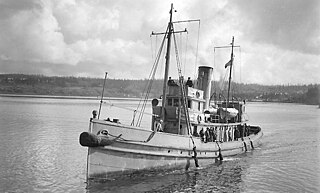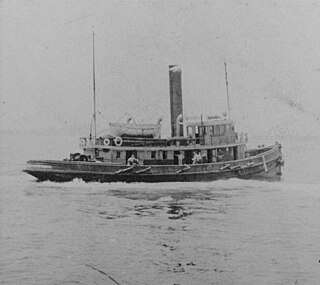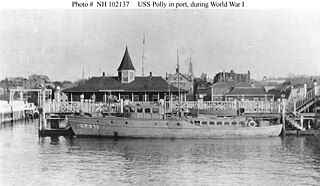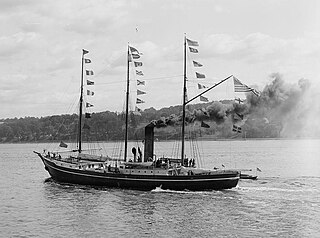
A. G. Prentiss was the 46 GRT wooden-hulled commercial vessel A. G. Prentiss launched 6 February 1912, by the Charles Ward Shipyard in Kennebunk, Maine, registered with official number 209585, for passenger service with home port at Saco, Maine. The vessel was named for Alfred G. Prentiss, owner of other tugs and a grain and groceries business. Despite the odd registration as "passenger" service when "tow" is one of the options, the vessel was well documented as a tug boat operating on the Saco River in Maine.

USS Impetuous (PYc-46) was a private yacht purchased by the Navy in August 1940 that served as a patrol boat of the United States Navy in Central America. The yacht was built as Paragon, the first of at least two Davol yachts to bear the name, in 1915 for Charles J. Davol of Providence, Rhode Island. In 1916 Davol sold the yacht to John Fred Betz, 3d of Philadelphia who renamed the yacht Sybilla III which served as the Section Patrol yacht USS Sybilla III (SP-104) from May 1917 to December 1918. Sybilla III remained in Betz's ownership until sale in 1935 to R. Livingston Sullivan of Philadelphia who renamed the yacht Arlis. On 12 August 1940 the Navy purchased the yacht placing it in commission as USS PC-454 on 16 October. The vessel was given the name Impetuous and reclassified PYc-46 on 15 July 1943. The yacht was decommissioned at Philadelphia 31 August 1944 and transferred to the War Shipping Administration for sale.

USS Fulton (AS-1) was constructed as a submarine tender in 1914, but later was converted into a gunboat and redesignated PG-49.

USS Challenge (SP-1015/AT-59/YT-126/YTM-126) was a commercial tugboat acquired by the United States Navy for service in World War I, and remained available for duty during World War II.

USS Druid (SP-321) was a private yacht launched 10 February 1902 as Rheclair that was built for Daniel G. Reid. Reid sold the yacht to Senator Nelson W. Aldrich who renamed the yacht Nirvana only just over a year before his death. Aldrich's estate chartered Nirvana to John Wanamaker until it was bought by his son Rodman Wanamaker who used the yacht for cruising until a fire on 14 December 1916, just before a cruise south, severely damaged the vessel. He chartered an alternate vessel for his trip south and, after full repairs, the yacht was sold to Walter W. Dwyer who gave it the name Druid with intentions to sell the yacht to the government in order to finance a shipyard venture in Pensacola, Florida.

USS Wachusetts (SP-548) was an armed motorboat that served in the United States Navy as a patrol vessel from 1917 to 1919. She was renamed SP-548 during her period of service. In 1919 she was transferred to the United States Bureau of Fisheries and renamed USFS Fulmar, and operated as a fisheries science research vessel on the Great Lakes until 1933 or 1934, when she was transferred to the Ohio Division of Conservation.

Bouker No. 2, originally Robert Rogers, was a tugboat built in 1904 for merchant service in and around the waters of New York City. During World War I, the tug was commissioned into the United States Navy as USS Bouker No. 2 (SP-1275), and continued in naval service until 1921. Briefly considered for service as a fireboat in Norfolk, Virginia, she was instead returned to merchant service in 1922 as a tugboat, under the name New York Marine Co. No. 6. She was sunk in collision with a passenger steamer in 1926.

USS Goliah (SP-1494), also listed as ID-1494, was an armed tug that served in the United States Navy as a patrol vessel and tug from 1918 to 1919.

USS Coco (SP-110) was an armed motorboat that served in the United States Navy as a Section patrol vessel from 1917 to 1919.

USS Owera (SP-167), was an armed yacht that served in the United States Navy as a patrol vessel from 1917 to 1919. The vessel, under the name O-We-Ra, was built as a steam yacht in Leith, Scotland in 1907 for Frederick H. Stevens of Buffalo, New York. In 1915 the yacht was sold to United States Senator Peter G. Gerry of Rhode Island and registered in Providence, Rhode Island as Owera.
The second USS Newark (SP-266) was a United States Navy minesweeper and tug in commission from 1917 to 1919.
USS Lowell (SP-504) was a United States Navy patrol vessel and minesweeper in commission from 1917 to 1919.

USS Dreadnaught (ID-1951), later YT-534 and YNG-21, was a United States Navy tug that was in service from 1918 to 1944.

USS Raeo (SP-588) was a United States Navy patrol vessel in commission from 1917 to 1919. Prior to her U.S. Navy service, she operated as the motor passenger vessel Raeo from 1908 to 1917. After the conclusion of her U.S. Navy career, she served as the fishery patrol vessel USFS Kittiwake in the United States Bureau of Fisheries fleet from 1919 to 1940 and as US FWS Kittiwake in the Fish and Wildlife Service fleet from 1940 to 1942 and from 1944 to at least 1945, and perhaps as late as 1948. During World War II, she again served in the U.S. Navy, this time as the yard patrol boat USS YP-199. She was the civilian fishing vessel Raeo from 1948 to 1957, then operated in various roles as Harbor Queen from 1957 to 1997. She became Entiat Princess in 1998 and as of 2009 was still in service.

The second USS Calypso (SP-632) was a United States Navy patrol vessel in commission from 1917 to 1919. She originally operated as the private motorboat Calypso from 1909 to 1917. After the conclusion of her U.S. Navy career, she served as the fishery patrol vessel in the United States Bureau of Fisheries fleet from 1919 to 1940 as USFS Merganser and in the Fish and Wildlife Service fleet as US FWS Merganser from 1940 to 1942.
F. Mansfield and Sons Co. (SP-691), sometimes seen as Mansfield & Sons Co., was a United States Navy mine sweeper serving in non-commissioned status, thus not properly bearing the U.S.S. prefix, from 1917 to 1919. The vessel was a small commercial freighter that was acquired by the Navy for World War I service. After the war the vessel was transferred to the United States Lighthouse Service for operation as a tender on 28 October 1919 and renamed Shrub. Upon merger of that service with the U.S. Coast Guard the vessel was designated the buoy tender USCGS Shrub until 1947.

USS Polly (SP-690) was a United States Navy patrol vessel in commission from 1917 to 1919. After the conclusion of her Navy career, she operated in the fleet of the United States Bureau of Fisheries as USFS Curlew.

The Type V ship is a United States Maritime Commission (MARCOM) designation for World War II tugboats. Type V was used in World War II, Korean War and the Vietnam War. Type V ships were used to move ships and barges. Type V tugboats were made of either steel or wood hulls. There were four types of tugboats ordered for World War II. The largest type V design was the sea worthy 186-foot (57 m) long steel hull, V4-M-A1. The V4-M-A1 design was used by a number of manufacturers; a total of 49 were built. A smaller steel hull tugboat was the 94-foot (29 m) V2-ME-A1; 26 were built. The largest wooden hull was the 148-foot (45 m) V3-S-AH2, of which 14 were built. The smaller wooden hull was the 58-foot (18 m) V2-M-AL1, which 35 were built. Most V2-M-AL1 tugboats were sent to England for the war efforts under the lend-lease act. The Type V tugs served across the globe during World War II including: Pacific War, European theatre and in the United States. SS Farallon and other Type V tugs were used to help built Normandy ports, including Mulberry harbour, on D-Day, June 6, 1944 and made nine round trips to Normandy to deliver Phoenix breakwaters.

SS Roosevelt was an American steamship of the early 20th century. She was designed and constructed specifically for Robert Peary′s polar exploration expeditions, and she supported the 1908 expedition in which he claimed to have discovered the North Pole.
















